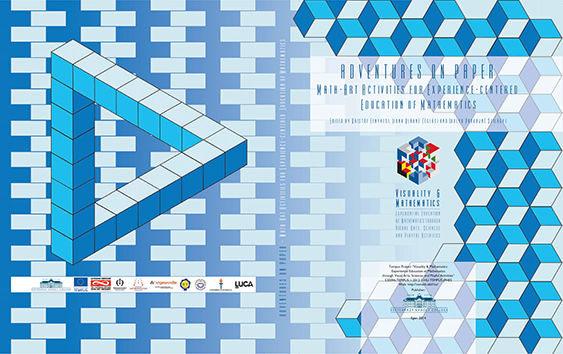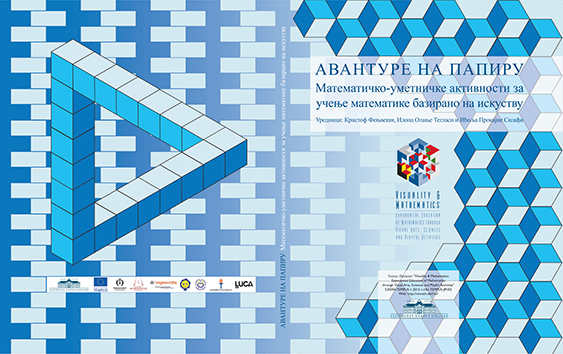
Adventures On Paper
Math-Art Activities for Experience-centered Education of MathematicsEdited by Kristóf Fenyvesi, Ilona Oláhné Téglási and Ibolya Prokajné Szilágyi
Publisher: Eszterházy Károly College, Eger, 2014
ISBN: 978-615-5297-25-0
This publication is a pedagogical toolkit, which presents hands-on materials and detailed methodological descriptions for the realization of almost forty interactive math-art workshops in the classroom. A number of significant international representatives of visual mathematics, mathematical art and experience-centered mathematics teaching have contributed and we have tried to cover a wide variety of topics. Most of the activities we selected can be completed with paper or cardboard on a cost-effective way and equipment readily-available in most educational institutions such as scissors and colouring pencils, and, at most, a photocopier.
We hope that the teachers who use our toolkit will succeed in encouraging their students to see mathematics as a joyful endeavour rather than the dry and boring subject many believe it to be. Moreover, we hope that this collection is adopted as a handbook not just by math teachers, but also by art teachers wishing to illuminate the links between the two disciplines of art and math.
 | Full book in English |
 | Full book in Serbian |
 | A supplement to the book by Dirk Huylebrouck |
GeoGebra Action Package (GAP) for the ADVENTURES ON PAPER exercise book
Please note, that you need to install GeoGebra on your computer to run the following files. GeoGebra is an open source software freely available for non-commercial users. You can download Geogebra from here: https://www.geogebra.org/download
 | Patterns, Symmetry, Modularity and Tile Games by Slavik Jablan and Ljiljana Radovic
|
 | Decoration of Polyhedra using Escher-like Tessellations by Robert Fathauer
|
 | Tangram-type Games Developing the Concept of Area and Volume by Ilona Oláhné Téglási
|
 | Möbius Strip and Frieze Symmetries by Eleonóra Stettner
|
 | The Polygonal Technique in Islamic Geometric Design by Jay Bonner
|
 | Arabesques and Quasicrsystals by Jean-Marc Castera
|
 | Decorating Regular Polyhedra Using Historical Persian Interlocking Star Polygonal Patterns by Reza Sarhangi
|
 | Impossible Objects, Paradox Figures by Tamás F. Farkas
|
 | Let us play Native American! by Georg Glaeser |
 | Design Anamorphosis in the Classroom by Kristóf Fenyvesi and Ildikó Szabó |
 | 3D Fractal Workshops by Dirk Huylebrouck
|
 | “Slide-Together” Geometric Paper Constructions by George Hart
|
 | Leonardo’s Elevated Polyhedra Models by Rinus Roelofs
|
 | Mathematical Adventures in Origami by Krystyna Burczyk and Wojtek Burczyk
|
All Geogebra applications and instructions were made by Eleonóra Stettner and the Tempus Geogebra Team.


 [
[ [
[ [
[
